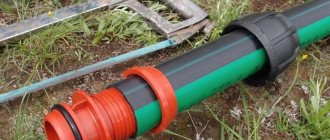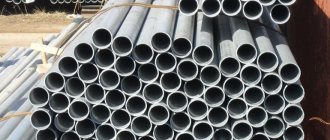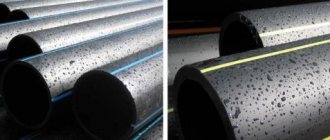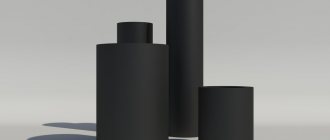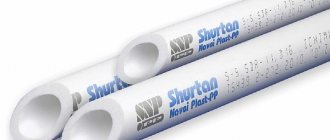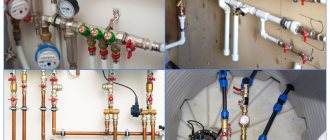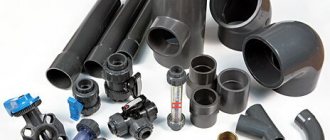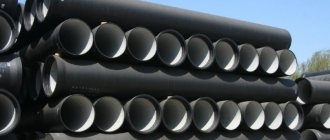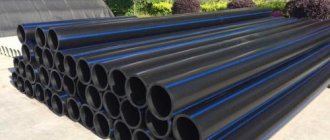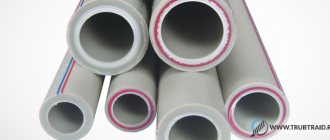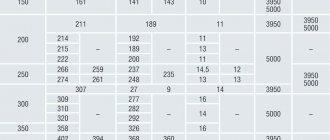In the construction market, polyethylene (PE) pipes are widely represented and popular. They are used in laying pipelines, in land reclamation, for constructing swimming pools, artesian wells, etc.
The quality of these products is regulated by GOST 18599-2001, which also describes all their technical and other characteristics. In this article we will review polyethylene pipe products, consider their main dimensions, markings, etc.
HDPE. What it is?
The abbreviation stands for low-density polyethylene. The pipe is made using extrusion technology: pressing molten raw materials through a mold. The production method includes the following steps:
- The initial polymer raw material is loaded into an extrusion hopper, where it melts under the influence of high temperatures. At this stage, additives are added to improve the performance properties of the finished product.
- The hopper maintains a given pressure, which promotes compaction of the material: individual molecules are converted into a monolithic crystalline network.
- The molten raw material passes through the extrusion head, cooling and taking on a marketable cylindrical shape.
- After this, the blanks are fed to a sizing mill, where they are processed to the specified diameter.
- At the final stage, markings are applied and the pipes are cut to lengths convenient for storage and sale.
There are 2 groups, depending on the area of application:
- Pressure – water supply, heating and sewerage systems.
- Gravity casing products that are suitable for high-voltage cables, drainage systems and water intake wells.
PE 100 SDR 11
The PE100 SDR 11 pipe is made from polyethylene produced at low pressure. At the same time, the high density of the material allows the use of such pipes for water supply systems with high pressure. The material used for the manufacture of pipes ensures high quality and environmental safety of drinking water.
Reliable and strong, they are able to withstand constant pressure of 16 atmospheres for 50 years. Such reliability and tolerance to aggressive environments makes it possible to use these pipes for gasification of populated areas. They are not afraid of stray currents, they can easily withstand variable soil loads. Pipes of this brand can be laid using the pulling method in the ground. The density of polyethylene allows them to be used as sewer collectors.
Scope of application of products manufactured using low pressure extrusion technology
The pipes are resistant to low-temperature effects; in extreme cases, the main line can be insulated. You need to pay attention to the upper temperature bar.
The melting point is +105 degrees, the pipe begins to soften and deform at +80 .
HDPE pipes are highly resistant to temperature changes and mechanical damage, which significantly expands their intended use. They are used:
- Electric installation work.
- Irrigation system equipment.
- Low pressure gas lines.
- Sewage systems.
- Hot and cold water supply.
- Pipelines with low burial depth.
- Wells and wells.
PE 100 SDR 26
For the production of such pipes, PE100 polyethylene is used, the distinctive qualities of which are high density, due to which pipes made from this material are superior to products made from PE80 in many respects, including long-term strength and resistance to cracking.
These pipes are used for transporting household and drinking water in urban areas and outside the city; they can also be used in sewerage systems, when drilling artesian wells, and creating a reclamation system. In factories and factories they will serve to supply milk, juice or wine.
In addition, the quality indicators of the material made it possible to significantly reduce the thickness of the walls of the product, which lightened its weight, but at the same time their throughput was 10-15% higher. The working pressure can be considered 6.3 atmospheres.
Technical characteristics GOST 18599 2001
Weight
Estimated weight of 1 meter of PE32 pipe in kg
| Outer diameter (nominal), mm | ||||
| SDR 6.0 | SDR 9.0 | SDR 13.60 | SDR 21.0 | |
| Wall thickness Sst., mm | ||||
| 2,50 | 4,0 | 6,30 | 10,0 | |
| 160 | 8,13 | 5,61 | 3,77 | |
| 140 | 6,24 | 4,29 | 2,89 | |
| 125 | 6,90 | 4,96 | 3,42 | 2,29 |
| 110 | 5,34 | 3,84 | 2,66 | 1,78 |
| 90 | 3,58 | 2,59 | 1,80 | 1,19 |
| 75 | 2,48 | 1,79 | 1,25 | 0,831 |
| 63 | 1,75 | 1,27 | 0,885 | 0,582 |
| 50 | 1,10 | 0,798 | 0,552 | 0,376 |
| 40 | 0,713 | 0,511 | 0,358 | 0,249 |
| 32 | 0,459 | 0,329 | 0,233 | 0,197 |
| 25 | 0,280 | 0,201 | 0,151 | |
| 20 | 0,182 | 0,134 | ||
| 16 | 0,116 | 0,92 | ||
| 12 | 0,065 | |||
| 10 | 0,052 | |||
Estimated weight of 1 meter of PE80, PE63, PE100 pipe in kg
| Outer diameter (nominal), mm | |||||||
| SDR6 | SDR7.4 | SDR13.6 | SDR17.6 | SDR21 | SDR 33.0 | SDR41 | |
| Wall thickness Sst., mm | |||||||
| 2,50 | 3,20 | 6,30 | 8,30 | 10,0 | 16,0 | 20,0 | |
| 1600 | 239 | 193 | |||||
| 1400 | 280 | 183 | 148 | ||||
| 1200 | 242 | 206 | 134 | 108 | |||
| 1000 | 214 | 168 | 143 | 93,5 | 75,4 | ||
| 900 | 173 | 136 | 116 | 75,9 | 60,9 | ||
| 800 | 137 | 108 | 91,4 | 59,9 | 48,3 | ||
| 710 | 108 | 84,7 | 72,1 | 47,3 | 38,1 | ||
| 630 | 84,8 | 66,6 | 56,6 | 37,1 | 29,9 | ||
| 560 | 67,1 | 52,6 | 44,8 | 29,4 | 23,6 | ||
| 500 | 92,1 | 53,5 | 42,0 | 35,8 | 23,5 | 19 | |
| 450 | 46,6 | 43,3 | 34,0 | 29,0 | 19,0 | 15,2 | |
| 400 | 69,0 | 59,0 | 34,2 | 26,9 | 22,9 | 15,1 | 12,1 |
| 355 | 54,4 | 46,4 | 27,0 | 21,2 | 18,0 | 11,8 | 9,53 |
| 315 | 42,8 | 36,6 | 21,3 | 16,7 | 14,2 | 9,35 | 7,49 |
| 280 | 33,9 | 28,9 | 16,8 | 13,2 | 11,3 | 7,38 | 5,96 |
| 250 | 27,0 | 23,1 | 13,4 | 10,6 | 8,91 | 5,9 | 4,81 |
| 225 | 21,9 | 18,7 | 10,9 | 8,55 | 7,29 | 4,76 | 3,84 |
| 200 | 17,3 | 14,8 | 8,56 | 6,78 | 5,77 | 3,82 | 3,3 |
| 180 | 14,0 | 12,0 | 6,98 | 5,71 | 5,47 | 3,78 | 2,47 |
| 160 | 11,1 | 9,46 | 5,5 | 4,35 | 3,71 | 2,41 | 1,98 |
| 140 | 8,49 | 7,27 | 4,22 | 3,35 | 2,83 | 1,87 | 1,53 |
| 125 | 6,77 | 5,78 | 3,37 | 2,66 | 2,26 | 1,5 | 1,25 |
| 110 | 5,25 | 4,49 | 2,61 | 2,07 | 1,77 | 1,16 | 0,93 |
| 90 | 3,52 | 3,00 | 1,76 | 1,40 | 1,18 | 0,782 | 0,63 |
| 75 | 2,45 | 2,09 | 1,23 | 0,97 | 0,821 | 0,543 | 0,469 |
| 63 | 1,73 | 1,47 | 0,869 | 0,682 | 0,573 | 0,392 | |
| 50 | 1,47 | 0,935 | 0,545 | 0,436 | 0.369 | ||
| 40 | 0,701 | 0,60 | 0,353 | 0,281 | 0,244 | ||
| 32 | 0,453 | 0,385 | 0,229 | ||||
| 25 | 0,277 | 0,24 | 0,148 | ||||
| 20 | 0,180 | 0,162 | |||||
| 16 | 0,115 | 0,102 | |||||
| 12 | 0,064 | ||||||
| 10 | 0,051 | ||||||
size table
| SDR 26 | SDR 21 | SDR 17 | SDR 13.6 | SDR 11 | ||||||
| PE 80 | PN 5 | PN 6.3 | PN 8 | PN 10 | PN 12.5 | |||||
| PE 100 | PN 6.3 | PN 8 | PN 10 | PN 12.5 | PN 16 | |||||
| Outer diameter, mm | Wall thickness, mm | Weight 1 m, kg | Wall thickness, mm | Weight 1 m, kg | Wall thickness, mm | Weight 1 m, kg | Wall thickness, mm | Weight 1 m, kg | Wall thickness, mm | Weight 1 m, kg |
| 20 | 2,0 | 0,116 | ||||||||
| 25 | 2,0 | 0,148 | 2,3 | 0,169 | ||||||
| 32 | 2,0 | 0,193 | 2,4 | 0,229 | 3,0 | 0,277 | ||||
| 40 | 2,0 | 0,244 | 2,4 | 0,292 | 3,0 | 0,353 | 3,7 | 0,427 | ||
| 50 | 2,0 | 0,308 | 2,4 | 0,369 | 3,0 | 0,449 | 3,7 | 0,545 | 4,6 | 0,663 |
| 63 | 2,5 | 0,488 | 3,0 | 0,573 | 3,8 | 0,715 | 4,7 | 0,869 | 5,8 | 1,05 |
| 75 | 2,9 | 0,668 | 3,6 | 0,821 | 4,5 | 1,01 | 5,6 | 1,23 | 6,8 | 1,46 |
| 90 | 3,5 | 0,969 | 4,3 | 1,180 | 5,4 | 1,45 | 6,7 | 1,76 | 8,2 | 2,12 |
| 110 | 4,2 | 1,420 | 5,3 | 1,770 | 6,6 | 2,16 | 8,1 | 2,61 | 10,0 | 3,14 |
| 125 | 4,8 | 1,830 | 6,0 | 2,260 | 7,4 | 2,75 | 9,2 | 3,37 | 11,4 | 4,08 |
| 140 | 5,4 | 2,310 | 6,7 | 2,830 | 8,3 | 3,46 | 10,3 | 4,22 | 12,7 | 5,08 |
| 160 | 6,2 | 3,030 | 7,7 | 3,710 | 9,5 | 4,51 | 11,8 | 5,50 | 14,6 | 6,67 |
| 180 | 6,9 | 3,780 | 8,6 | 4,660 | 10,7 | 5,71 | 13,3 | 6,98 | 16,4 | 8,43 |
| 200 | 7,7 | 4,680 | 9,6 | 5,770 | 11,9 | 7,04 | 14,7 | 8,56 | 18,2 | 10,4 |
| 225 | 8,6 | 5,880 | 10,8 | 7,290 | 13,4 | 8,94 | 16,6 | 10,9 | 20,5 | 13,2 |
| 250 | 9,6 | 7,290 | 11,9 | 8,920 | 14,8 | 11,0 | 18,4 | 13,4 | 22,7 | 16,2 |
| 280 | 10,7 | 9,090 | 13,4 | 11,300 | 16,6 | 13,8 | 20,6 | 16,8 | 25,4 | 20,3 |
| 315 | 12,1 | 11,600 | 15,0 | 14,200 | 18,7 | 17,4 | 23,2 | 21,3 | 28,6 | 25,7 |
| 355 | 13,6 | 14,600 | 16,9 | 18,000 | 21,1 | 22,2 | 26,1 | 27,0 | 32,2 | 32,6 |
| 400 | 15,3 | 18,600 | 19,1 | 22,900 | 23,7 | 28,0 | 29,4 | 34,2 | 36,3 | 41,4 |
| 450 | 17,2 | 23,500 | 21,5 | 29,000 | 26,7 | 35,5 | 33,1 | 43,3 | 40,9 | 52,4 |
| 500 | 19,1 | 29,000 | 23,9 | 35,800 | 29,7 | 43,9 | 36,8 | 53,5 | 45,4 | 64,7 |
| 560 | 21,4 | 36,300 | 26,7 | 44,800 | 33,2 | 55,0 | 41,2 | 67,1 | 50,8 | 81,0 |
| 630 | 24,1 | 46,000 | 30,0 | 56,500 | 37,4 | 69,6 | 46,3 | 84,8 | 57,2 | 103,00 |
| 710 | 27,2 | 58,500 | 33,9 | 72,100 | 42,1 | 88,4 | 52,2 | 108,00 | 64,5 | 131,00 |
| 800 | 30,6 | 74,100 | 38,1 | 91,400 | 47,4 | 112,0 | 58,8 | 137,0 | 72,6 | 166,00 |
| 900 | 34,4 | 93,800 | 42,9 | 116,000 | 53,3 | 142,0 | 66,1 | 173,00 | ||
| 1000 | 38,2 | 116,000 | 47,7 | 143,000 | 59,3 | 175,0 | 73,5 | 214,00 | ||
| 1200 | 45,9 | 167,000 | 57,2 | 206,000 | 71,1 | 252,0 | ||||
The file with the complete document of the interstate standard is here >>>
HDPE pipes ∅ up to 110 mm are supplied in coils and in sections of 12 meters.
Pipes with a diameter of more than 110 mm are supplied only in 12-meter lengths.
Coil diameter table
| HDPE pipe diameter, mm | Coil length, m | Overall dimensions, m |
| 32 | 100 | 1,2 |
| 40 | 100 | 1,4 |
| 50 | 100 | 1,5 |
| 63 | 100 | 2 |
| 75 | 100 | 2,2 |
| 75 | 50 | 1,9 |
| 90 | 100 | 2,7 |
| 90 | 50 | 2,5 |
| 110 | 100 | 3 |
| 110 | 50 | 2,8 |
What does SDR mean?
If we look at the dry decoding, the abbreviation SDR comes from the English Standard Dimension Ratio , which means standard dimensional ratio. Its essence comes down to the ratio of the diameter to the pipe wall. This value is determined not only by the thickness of the polymer layer, but also by the ability of the product to withstand internal and external loads.
SDR by inverse proportions: the higher the index, the thinner the wall. Therefore, products of the same size group, but with different SDR , have different intended uses. For example:
- SDR 13.6 – have high strength and are therefore suitable for capital water supply systems.
- SDR 17 - pipes with an average rating, which are used in low-rise construction.
- SDR 21 – not suitable for pressure systems and underground communications.
Note: in all three cases, we are talking about PE 80 .
| SDR 41 | SDR 33 | SDR 26 | SDR 21 | SDR 17,6 | SDR 17 | SDR 13,6 | SDR 11 | SDR 9 | SDR 7,4 | SDR 6 |
| 4 atm. | 4 atm. | 5 atm. | 6 atm. | 7 atm. | 8 atm. | 10 atm. | 12 atm. | 16 atm. | 20 atm. | 25 atm. |
PE 100 SDR 17
Pipes marked PE 100 SDR 17 are new generation pipes. Their feature is uniquely high strength indicators, which has a significant impact on enhancing the performance characteristics of polyethylene pipes. They tolerate constant pressure of 10 atmospheres well.
Pipes of this type are recommended for use in pressure water supply systems and gas pipelines. Moreover, such pipes are considered ideal for the installation of pipelines with a large cross-section. When manufacturing pipes of this type, material savings are very significant due to the possibility of reducing the wall thickness while maintaining the high strength of the product. The technical characteristics of such pipes allow their widespread use in the construction of long-distance pipelines.
Marking - symbols
The intended use is indicated by a colored stripe that runs along the side of the product. This means the following:
- Blue color – water supply.
- Yellow – gas industry.
- Lack of color bar - technical needs.
In addition, products are marked according to their ability to withstand a certain pressure. It looks like this:
- PE 33 – up to 3.3 MPa (such pipes are practically never found).
- PE 63 – up to 6.3 MPa.
- PE 80 – up to 8 MPa.
- PE 100 – up to 10 MPa.
In the international format, such characteristics are designated as PE .
Transcript example
Let's decipher the marking of the PE 80 SDR13.6 40x1.2 drinking pipe GOST 18599-2001 , where:
- PE 80 – category of polyethylene and nominally permissible pressure.
- SDR13.6 – coefficient of ratio between diameter and wall thickness.
- 40x1.2 – pipe diameter and actual wall thickness.
- Drinking – specific application, in our case, suitable for laying pipelines with drinking water.
- GOST 18599-2001 is the state standard to which this product complies.
Labeling may include production date and batch number.
Diameter of polymer pipes
The diameters of polyethylene pipes are also strictly standardized. Unlike gas pipes, water supply systems are manufactured in the range from 10 to 300 mm. In some cases, it is also possible to use a 600 mm pipe, but exclusively as an external non-pressure sewer system.
Pipes for external water supply with large diameter
The most common are low pressure polyethylene pipes of 20 mm, 25 mm, 50 mm, 100 mm and 160 mm. To calculate their internal diameter, which, by the way, is not indicated in the standard marking, you need to subtract the wall thickness from the outer diameter. Fittings are calculated in a similar way.
The resulting difference will be the internal diameter. Naturally, having all this data, you can also easily calculate the SDR for the pipes. For diameter 20, the minimum ratio between diameter and wall should be 2.8.
What is the difference between HDPE and PVD?
In both cases, we are talking about products made of polymer material manufactured by extrusion. Differences in production technology: LDPE – high-density polyethylene. When granules are loaded into an extrusion hopper, high pressure is maintained inside, which affects the performance properties of the finished products.
In particular, high pressure does not promote strong compaction, so the molecules form branched lateral bonds. The result is a more plastic structure, which determines the specific application.
LDPE pipes are used for the installation of:
- Reclamation wells
- Internal water supply (cold)
- Water disposal.
Due to their high ductility, products in this series have proven themselves to be excellent as embedded elements in monolithic construction and insulation of underground power cables.
The maximum permissible temperature of such products is only +40 degrees, so the pipes are not suitable for hot water supply and heating systems.
In addition, LDPE pipes have a large diameter and can be sold in coils of up to 100 meters.
PE 100 SDR 21
PE 100 SDR 21 pipes are used for the construction of water pipelines. Passing through pipes of this type, water retains its taste and is characterized by the absence of foreign odors. They are often used not only in suburban construction, but also to create reclamation and irrigation systems, and when installing suburban water supply systems. High-strength polyethylene can withstand high pressure, and PE 100 SDR 21 pipes can be used as an element of a cold water supply system in high-rise buildings.
These pipes have excellent strength characteristics and are ideal for water supply. They are compatible with metal pipes (steel, cast iron) using special adapters. Corrosion processes, other types of destruction and blockages in such pipes are not dangerous. At a constant water temperature of +20°C, the pipes can withstand a pressure of 8 atmospheres.
Options for reliable insulation of polyethylene pipes
- Glass wool is a short-lived but affordable insulation material that requires additional external insulation.
- Basalt insulation is a more functional analogue of the previous material.
- Polystyrene foam - available in shell form, does not require additional insulation, and is suitable for repeated use.
A good option would be to purchase an already insulated HDPE pipe. This is a two-layer structure, where an insulating layer is laid on top of a plastic pipe, covered with an outer shell. However, such products are noticeably more expensive.
Read about Energoflex flexible insulation.
Properties, advantages, disadvantages
Polyethylene pipes are used to transport various liquid and gaseous substances. In the literature you can find an abbreviated designation: in the Russian version it is PE, in the international version it is PE or PE-X for cross-linked polyethylene.
They have excellent properties:
- The material is chemically neutral and does not react even with hydrochloric acid. Due to this they are used in production processes.
- In its normal state it does not emit any substances and do not affect the taste of transported liquids. This allows them to be used in the construction of pipelines through which liquids that can be consumed circulate.
- The inner walls of polyethylene pipes are very smooth and no substances are retained on them. Even after many years there will be no deposits on them.
Polyethylene pipes can be of different diameters, with different wall thicknesses
Compression fittings for polyethylene pipes are simply screwed into place
An excellent set of properties has led to the fact that polyethylene pipes are becoming increasingly popular. But to avoid surprises, you need to know their shortcomings. There are not very many of them, but they are quite serious.
- Polyethylene burns and releases harmful substances when burned.
- Weak resistance to ultraviolet radiation. When exposed to the sun, the material becomes brittle and brittle. But cross-linked polyethylene pipes are not susceptible to this disease; they have recently become the best sellers.
- Large thermal expansion - it is 10 times greater than that of steel. To neutralize this drawback, a compensator is installed.
- When the liquid in the pipeline freezes, the polyethylene may rupture. Therefore, when using polyethylene pipes to organize water supply for a private house or cottage, it is laid below the freezing depth or insulated on top, and additional heating methods (heating cables) are used.
These are all shortcomings. Now about the varieties. According to the production method, there are three types of polyethylene pipes:
- high pressure;
- low pressure;
- made of cross-linked polyethylene (often red, as in most cases they are used for laying heating and hot water systems).
Cross-linked polyethylene tolerates transportation of hot media
There is a certain paradox hidden in these names. When they talk about high or low pressure polyethylene pipes, they mean the method of their production. But often it is perceived as an area of use. In reality, it's the other way around. Pipes produced at high pressure are less durable. They can only be used for free-flow systems (without pumps). They are made for pressure water supply systems, but the strength is gained due to the thickness of the walls. With normal wall thickness, their area of use is sewerage, drainage systems, storm drains, etc. Here their qualities are optimal.
In pressure pipelines, where there is high pressure, low-pressure polyethylene pipes are used. They are more durable but, at the same time, more fragile and bend much worse. This is also not very good. But they can withstand significant pressure changes without any harm. And it must also be said that both of these types of polyethylene pipes are only suitable for cold water - they cannot withstand hot water and can melt.
Pipes made of cross-linked polyethylene PE-X are used in the installation of water heated floors
But the third type - made of cross-linked polyethylene - is an option with high strength and flexibility. Such products can withstand high pressure (up to 20 atm) and temperatures up to +95°C, that is, PE-X pipes can be used for hot water supply, as well as for heating systems. By the way, this type of polymer is used to make metal-plastic pipes. However, there is one “but” here - this type of material cannot be welded. When installing a pipeline made of cross-linked polyethylene, fittings with gaskets are used. The second type of assembly is adhesive, when the joints of the connected elements are coated with glue.
Polyethylene pipelines – areas of application
HDPE pipe
The key difference between HDPE pipes is their environmental friendliness, biological neutrality, resistance to deposits on the walls and most chemicals, including acids and alkalis. Features of production (as in other types of pipe products) are reflected in the marking code, deciphering which will help in choosing the right type from the presented assortment.
Appearance
According to GOST, pressure pipes are manufactured for water for various purposes in the temperature range from 0 to +40 degrees.
These include pipes:
- with marking stripes;
- with co-extrusion layers located inside or outside, with the same MRS (the manufacturer indicates the thickness of each layer);
- with additional protective layers of thermoplastic.
Polyethylene pipe with external protection
All of them must comply with the same hygienic and technical indicators, appearance requirements:
- No cracks, bubbles, cavities or foreign inclusions.
- Smooth surface with minimal waviness or streaking that does not affect wall thickness.
- The color is often blue or black, with at least three marking stripes evenly distributed around the circumference.
Pipe with a blue stripe for water
All small-diameter pipes are produced in straight sections and in coils (coils). Diameters above 180 mm are only available in lengths from 5 m (less commonly, lengths of 3 m are found) to 24, but must be a multiple of 25 cm.
How to properly connect HDPE pipes
One of the main advantages of HDPE pipes is the possibility of self-assembly, and a huge variety of fitting elements (couplings, adapters, elbows, plugs, etc. fittings) allows you to assemble a water main of any configuration.
The specificity of the material gives the user the right to choose the most convenient method of assembling the pipeline from the four currently practiced:
- Butt welding.
- Electrofusion welding.
- Via compression fittings.
- Flange connection.
The first two methods are classified as one-piece and provide the greatest strength and tightness. The last two make it possible to disassemble the connection if necessary and reassemble it again.
Permanent connection methods
Electrofusion (electrodiffusion) welding is performed using polymer thermoresistive fittings (electrofusions), on the inside of which a special heating coil is mounted. The pipes inserted into the fitting are connected due to the melting of the polymer layer on the walls of the joined parts. The welding mode is set by sensors and a bar code printed on the coupling, and is read and controlled by an electric welding machine connected to the fitting through the terminals installed on it.
Installation of a HDPE pipeline using electrofusion welding is relevant for:
- Laying a pipeline in deep soil (especially in seismically active areas).
- Connecting pipes with a cross-section over 2 cm and a wall thickness of 3 mm.
Butt welding involves the use of specialized welding equipment (soldering iron), which melts sections of HDPE pipes. Then these ends are connected to each other. This method will require careful preparation and development of the “gluing” skill. The ends of the joined sections must be cut perfectly evenly (at an angle of 90°C), and when combining the molten ends, it is important to control the degree of pressure and avoid turning the parts.
Important! Due to the flow seam formed by the melted plastic, the throughput of the water main is reduced. Therefore, butt welding technology is not used for HDPE pipes with a cross-section of up to 50 mm.
The use of detachable connections when installing HDPE pipelines
The compression type of connection is perhaps the most popular in the field of private construction, but it is recommended exclusively for cold water supply systems. Compression fittings, the key element of which are crimp nuts, not only provide a reliable connection, but also allow you to switch to a threaded connection, which is so necessary when connecting to a metal line.
Flange technology for assembling HDPE pipelines is rarely used in private construction. But in cases where it is necessary to make a threadless transition to another type of pipe, this connection method is considered indispensable. In fact, a flange (an end element in the form of a round or rectangular plate with holes for bolts) must first be welded to the joined sections using one of the above methods, then the pipes are pulled together using these flanges. For tightness, a rubber gasket is placed between the flanges.
Important! Due to the need for systematic preventive inspections, pipelines installed using compression or flange methods cannot be immersed in the ground.
